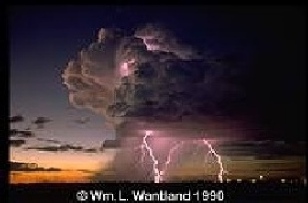Research on NOx Production in Lightning

Barth MC, Kim SW, Wang C, Pickering, KE et al.
Cloud-scale model intercomparison of chemical constituent transport in deep convection
ATMOSPHERIC CHEMISTRY AND PHYSICS 7 (18): 4709-4731 2007.
Barth MC, Kim SW, Skamarock WC, Pickering KE, et al.
Simulations of the redistribution of formaldehyde, formic acid, and peroxides in the 10 July 1996 Stratospheric-Tropospheric Experiment: Radiation, Aerosols, and Ozone deep convection storm
JOURNAL OF GEOPHYSICAL RESEARCH-ATMOSPHERES 112 (D13): Art. No. D13310 JUL 12 2007.
Thompson AM, Stone JB, Witte JC, Pickering KE, et al.
Intercontinental Chemical Transport Experiment Ozonesonde Network Study (IONS) 2004: 2. Tropospheric ozone budgets and variability over northeastern North America
JOURNAL OF GEOPHYSICAL RESEARCH-ATMOSPHERES 112 (D12): Art. No. D12S13 MAY 15 2007.
Ott LE, Pickering KE, Stenchikov GL, et al.
Effects of lightning NOx production during the 21 July European Lightning Nitrogen Oxides Project storm studied with a three-dimensional cloud-scale chemical transport model
JOURNAL OF GEOPHYSICAL RESEARCH-ATMOSPHERES 112 (D5): Art. No. D05307 MAR 14 2007
Bertram TH, Perring AE, Wooldridge PJ, Pickering KE, et al.
Direct measurements of the convective recycling of the upper troposphere
SCIENCE 315 (5813): 816-820 FEB 9 2007.
STERAO-A and CRYSTAL-FACE:
We participated in a Colorado-based field experiment (STERAO-A) and Florida-based CRYSRAL-FACE designed to
study convective transport of trace gases and to study the production of NOx by
lightning. We have developed a lightning NOx algorithm for the Goddard
Cumulus Ensemble Model. Use of the model in conjunction with NOx mixing
ratios measured by aircraft in the anvils of the STERAO-A thunderstorms has
allowed us to estimate the amount of NO produced per flash. In previous
work we used the cloud model to determine the shape of the vertical profile
of lightning NOx at the end of a thunderstorm. These profiles are being applied
in lightning NOx parameterizations in regional and global models.
Pickering, K. E., Y. Wang, W.-K. Tao, C. Price, and J.-F. Mueller, Vertical
distributions of lightning NOx for use in regional and global chemical
transport models, J. Geophys. Res., 103, 31,203-31,216, 1998.
DeCaria, A. J., K. E. Pickering, G. L. Stenchikov, J. R. Scala, J. L. Stith,
J. E. Dye, B. A. Ridley, and P. Laroche, A cloud-scale model study
of lightning-generated NOx in an individual thunderstorm during
STERAO-A, J. Geophys. Res., 105(D9), 11601-11616, 2000 .
Jeker D. P., Pfister L., Thompson A. M., Pickering K. E., et al.,
Measurements of nitrogen oxides at the tropopause: Attribution to convection and correlation with lightning
J. Geophys. Res. 105(D3), 3679-3700, 2000.
Collaboration with the Physics Department
Lightning is a major source of nitric oxide (NO) in remote areas of the
atmosphere. Laboratory investigations in collaboration with
colleagues in the Department of Physics have provided insight into the
dependence of this production on energy, current, and
pressure.
Nitric Oxide Production by Simulated Lightning: Dependence on Current,
Energy, and Pressure, Y. Wang, A. W. DeSilva, G. C. Goldenbaum, and
R. R. Dickerson, J. Geophys. Res., 103(15), 19,149-19,159, 1998.
Full paper Downloadable
version
Last revised December 24, 2007.

